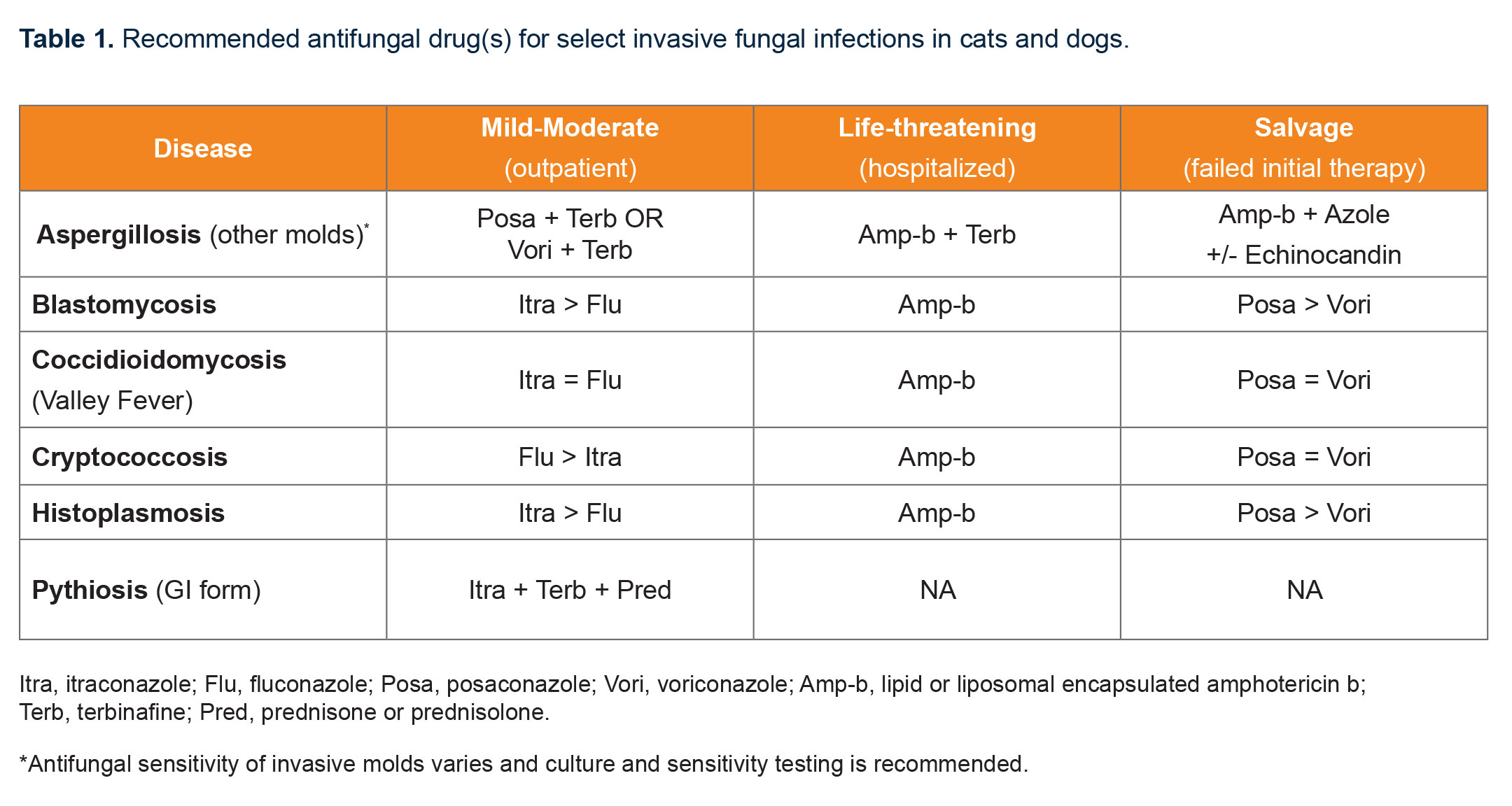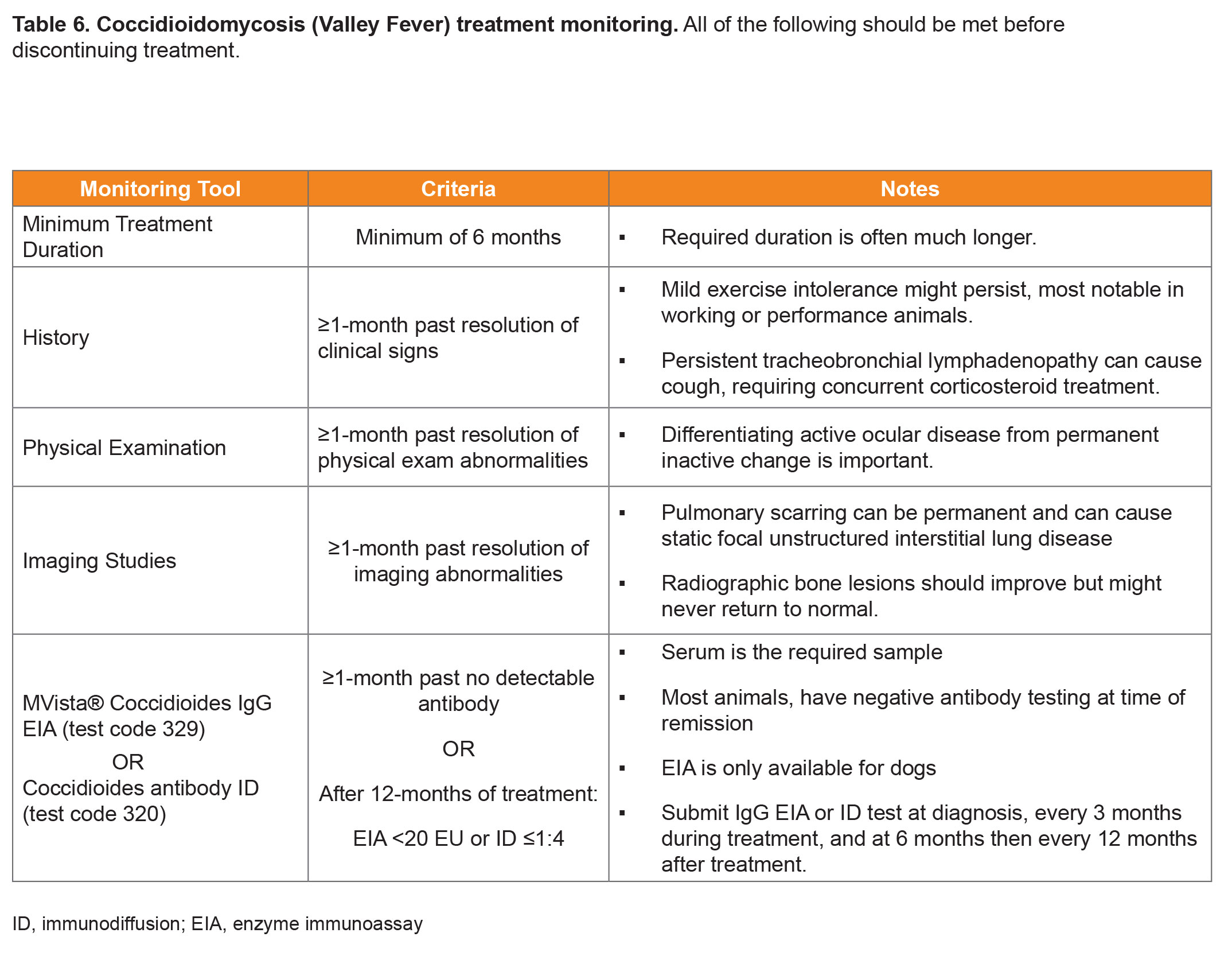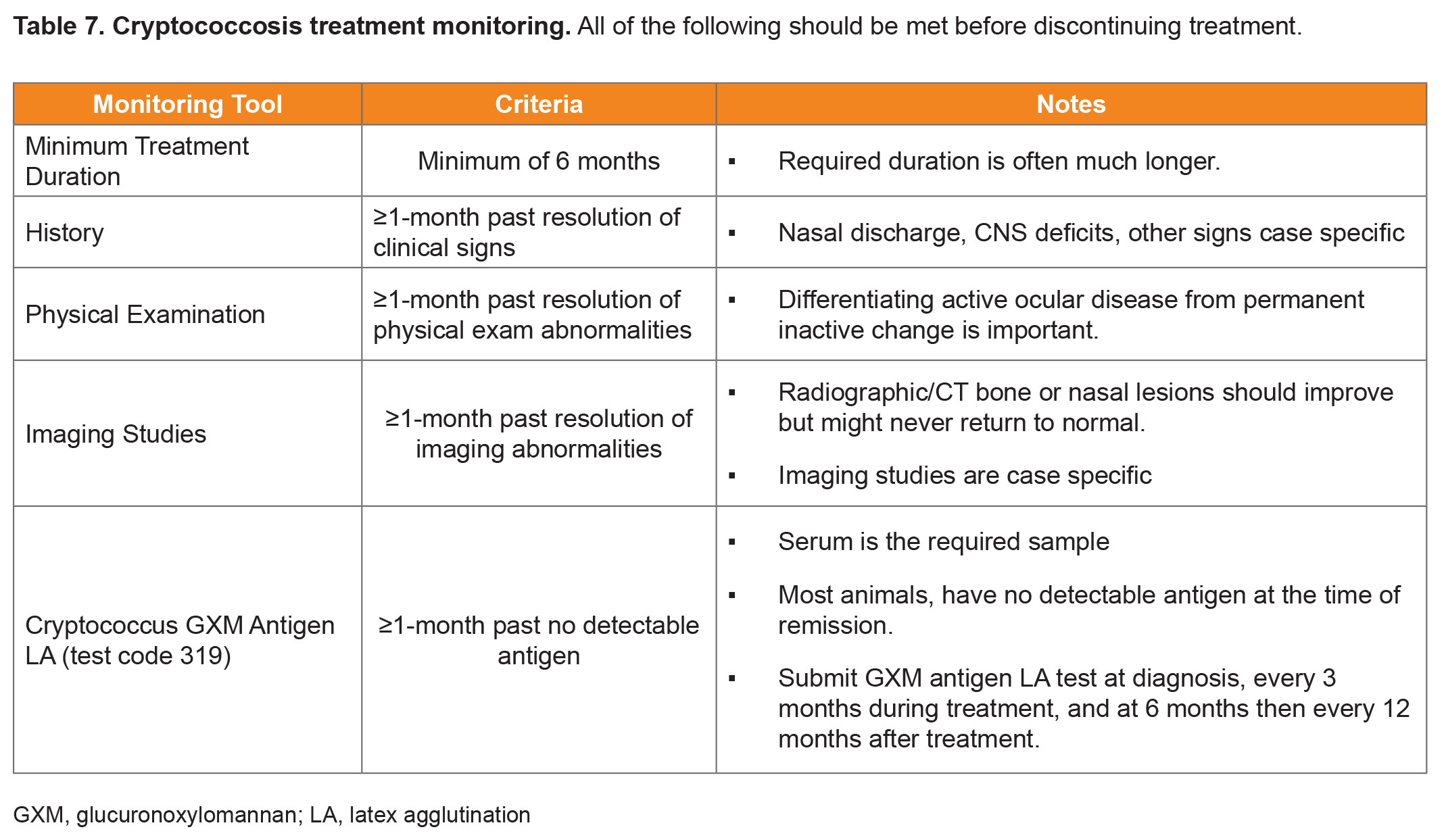When to Stop Antifungal Medication(s)
Invasive fungal infections (IFI) can be challenging to diagnose. In some cases, however, the biggest challenge is treatment. More specifically, how to monitor treatment and when to discontinue antifungal drug(s) is most difficult. Biomarkers (fungal antigens and antibodies) are useful for treatment monitoring. MVD recommends a multi-modal approach to treatment monitoring that includes clinical signs, physical examination, imaging studies and repeat biomarker testing. Below is a table for each common IFI – systemic aspergillosis, blastomycosis, coccidioidomycosis (Valley Fever), cryptococcosis, and histoplasmosis (Tables 4-8). In addition, a common fungal-like oomycosis, pythiosis, is included. Beforehand, there is a brief review of treatment recommendations (Tables 1 & 2) and diagnostic performance of common fungal biomarker tests (Table 3). It is important to check itraconazole blood levels (MVista Itra Bioassay, test code 312) after 3 weeks of treatment ideally within 4-hours of the next dose (near-trough level).
REFERENCES:
- Renschler J, Albers A, Sinclair-Mackling H, et al. Comparison of compounded, generic, and innovator-formulated itraconazole in dogs and cats. J Am Anim Hosp Assoc 2018;54:195-200.
- Motschenbacher LO, Furrow E, Rendahl AK, et al. Retrospective analysis of the effects of Blastomyces antigen concentration in urine and radiographic findings on survival in dogs with blastomycosis. J Vet Intern Med 2021.
- Mourning AC, Patterson EE, Kirsch EJ, et al. Evaluation of an enzyme immunoassay for antibodies to a recombinant Blastomyces adhesin-1 repeat antigen as an aid in the diagnosis of blastomycosis in dogs. J Am Vet Med Assoc 2015;247:1133-1138.
- Spector D, Legendre AM, Wheat J, et al. Antigen and antibody testing for the diagnosis of blastomycosis in dogs. J Vet Intern Med 2008;22:839-843.
- Foy DS, Trepanier LA, Kirsch EJ, et al. Serum and urine Blastomyces antigen concentrations as markers of clinical remission in dogs treated for systemic blastomycosis. J Vet Intern Med 2014;28:305-310.
- Arambulo PV, 3rd, Topacio TM, Jr., Famatiga EG, et al. Leptospirosis among abattoir employees, dog pound workers, and fish inspectors in the city of Manila. The SE Asian J Trop Med Pub Health 1972;3:212-220.
- Morris JM, Sigmund AB, Ward DA, et al. Ocular findings in cats with blastomycosis: 19 cases (1978-2019). J Am Vet Med Assoc 2021;260:422-427.
- Hecht S, Michaels JR, Simon H. Case report: MRI findings with CNS blastomycosis in three domestic cats. Front Vet Sci 2022;9:966853.
- Arceneaux KA, Taboada J, Hosgood G. Blastomycosis in dogs: 115 cases (1980-1995). J Am Vet Med Assoc 1998;213:658-664.
- Crews LJ, Feeney DA, Jessen CR, et al. Utility of diagnostic tests for and medical treatment of pulmonary blastomycosis in dogs: 125 cases (1989-2006). J Am Vet Med Assoc 2008;232:222-227.
- Cunningham L, Cook A, Hanzlicek A, et al. Sensitivity and specificity of Histoplasma antigen detection by enzyme immunoassay. J Am Anim Hosp Assoc 2015;51:306-310.
- Clark K, Hanzlicek AS. Evaluation of a novel monoclonal antibody-based enzyme immunoassay for detection of Histoplasma antigen in urine of dogs. J Vet Intern Med 2020.
- Cook AK, Cunningham LY, Cowell AK, et al. Clinical evaluation of urine Histoplasma capsulatum antigen measurement in cats with suspected disseminated histoplasmosis. J Feline Med Surg 2012;14:512-515.
- Rothenburg L, Hanzlicek AS, Payton ME. A monoclonal antibody-based urine Histoplasma antigen enzyme immunoassay (IMMY(R)) for the diagnosis of histoplasmosis in cats. J Vet Intern Med 2019;33:603-610.
- Hanzlicek AS, Meinkoth JH, Renschler JS, et al. Antigen Concentrations as an indicator of clinical remission and disease relapse in cats with histoplasmosis. J Vet Intern Med 2016;30:1065-1073.
- Holbrook ED, Greene RT, Rubin SI, et al. Novel canine anti-Coccidioides immunoglobulin G enzyme immunoassay aids in diagnosis of coccidioidomycosis in dog Med Mycol 2019;57:800-806.
- Kirsch EJ, Greene RT, Prahl A, et al. Evaluation of Coccidioides antigen detection in dogs with coccidioidomycosis. Clin Vaccine Immunol 2012;19:343-345.
- Johnson LR, Herrgesell EJ, Davidson AP, et al. Clinical, clinicopathologic, and radiographic findings in dogs with coccidioidomycosis: 24 cases (1995-2000). J Am Vet Med Assoc 2003;222:461-466.
- Gunstra A, Steurer JA, Seibert RL, et al. Sensitivity of serologic testing for dogs diagnosed with coccidioidomycosis on histology: 52 Cases (2012-2013). J Am Anim Hosp Assoc 2019;55:238-242.
- Arbona N, Butkiewicz CD, Keyes M, et al. Clinical features of cats diagnosed with coccidioidomycosis in Arizona, 2004-2018. J Feline Med Surg 2020;22:129-137.
- Greene RT, Troy GC. Coccidioidomycosis in 48 cats: a retrospective study (1984-1993). J Vet Intern Med 1995;9:86-91.
- Malik R, McPetrie R, Wigney DI, et al. A latex cryptococcal antigen agglutination test for diagnosis and monitoring of therapy for cryptococcosis. Aust Vet J 1996;74:358- 364.
- Johnston L, Mackay B, King T, et al. Abdominal cryptococcosis in dogs and cats: 38 cases (2000-2018). J Small Anim Pract 2021;62:19-27.
- Trivedi SR, Sykes JE, Cannon MS, et al. Clinical features and epidemiology of cryptococcosis in cats and dogs in California: 93 cases (1988-2010). J Am Vet Med Assoc 2011;239:357-369.
- Medleau L, Marks MA, Brown J, et al. Clinical evaluation of a cryptococcal antigen latex agglutination test for diagnosis of cryptococcosis in cats. J Am Vet Med Assoc 1990;196:1470-1473.
- Garcia RS, Wheat LJ, Cook AK, et al. Sensitivity and specificity of a blood and urine galactomannan antigen assay for diagnosis of systemic aspergillosis in dogs. J Vet Intern Med 2012;26:911-919.
- Billen F, Peeters D, Peters IR, et al. Comparison of the value of measurement of serum galactomannan and Aspergillus-specific antibodies in the diagnosis of canine sinonasal aspergillosis. Vet Microbiol 2009;133:358-365.
- Whitney J, Beatty JA, Martin P, et al. Evaluation of serum galactomannan detection for diagnosis of feline upper respiratory tract aspergillosis. Vet Microbiol 2013;162:180- 185.
- Barrs VR, Ujvari B, Dhand NK, et al. Detection of Aspergillus-specific antibodies by agar gel double immunodiffusion and IgG ELISA in feline upper respiratory tract aspergillosis. Vet J 2015;203:285-289.










